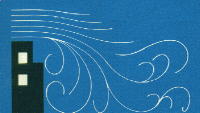How to Measure the Wind
If you can’t see the wind, how can you tell how fast it is moving?
Actually, it’s very easy. You can’t see the wind, but you can see what it does to other things around you. You know it is windy because you can feel the breeze on your face. You can see the leaves in the trees outside shaking. You hear the flag at the post office down the street waving very proudly.
On days when the flag waves, the wind is moving faster than you can ride your bicycle, even when you pedaled very hard.
Let’s talk about wind speed. We will describe it in miles-per-hour. That’s the same way we describe how fast a car moves. But instead of looking at the car’s speedometer, we will use the natural wind speedometer that is all around us in nature.
Natural Wind Speedometer
 |
1-3 mph | Smoke drifts lazily, branches are still, flags hang limp |
  |
4-7 mph | Tree leaves rustle, flags move slowly |
   |
8-12 mph | Flags fly, bushes shake, leaves move |
    |
13-18 mph | Small branches shake, grass moves |
     |
19-24 mph | Large branches sway, flags flap noisily |
      |
25-31 mph | Trees shake, dust and sand flies |
The best time to fly a kite is when the wind is between 4 and 12 miles-per-hour. If the wind is less, then most kites have problems flying. If the wind is more, then most kites will lose control. So watch the trees, bushes, flags and grass to know when the wind is just right.
The other thing to watch for is wind turbulence. Turbulence is what happens when the wind gets bumpy. And it is very difficult to fly a kite well in bumpy wind.


Think of wind flowing over the land just like water flows down a river. If the river is wide and smooth, the water will be smooth too. But if the river is going over rocks, around curves, or downhill, it will run fast and rough.
The same thing happens to wind when it flows over trees, past buildings, or over hills.

Kite fliers have a rule. We know that wind will be bumpy after going over or around an obstacle. We have measured how long it takes to smooth out. That distance is seven times the hight of the obstacle. So if a tree is 100 feet tall, you need to be 700 feet away from the tree to avoid the bumpy wind. Otherwise, the wind may reach out and pull your kite into the tree or crash it to the ground.
